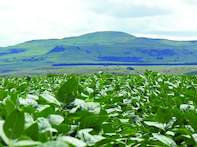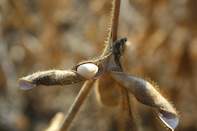Soybeans were domesticated more than 3 000 years ago from wild soybean in East Asia, where it has since been used as a food source, medicine and animal feed. Today, it is one of the most important oilseed crops, accounting for more than half of the world’s oilseed production.

Its high protein content makes it a perfect dairy and meat substitute and valuable animal feed ingredient. It is also an excellent rotational crop, especially in maize rotations, primarily because of its ability to fix nitrogen and break pest and disease problems associated with mono-cropping.
Besides this, soybeans have industrial uses, with Henry Ford allegedly using soybean “plastic” for the gearshift knobs, horn buttons, window frames, accelerator pedals, light switch assemblies and ignition-coil casings in one of the cars he manufactured. According to the North Carolina Soybean Producers Association, Ford used one bushel of soybean for every car he manufactured.
Global Production
Soybean production has dramatically increased and expanded over the past decade, increasing from 27 million tons in the 1970s to roughly 365 million tons during the 2019/2020 season. Demand is primarily driven by world population growth, which is requiring food production to almost double over the next thirty years.
Soybeans is an important crop in this regard, because it produces more protein than any other crop per hectare and is also an important feed crop, and therefore helps to address the growing demand for animal protein.
Brazil and the United States are the biggest international soybean producers. During the 2017/2018 season Brazil took the first place, producing 122 million tons in comparison with a 121 million tons from the United States, according to the Oilseeds – World Markets and Trade publication of the United States Department of Agriculture (USDA).
The United States reclaimed the first position during the 2018/2019 season, producing 121 million tons in comparison with 117 million tons from Brazil, whereas Brazil then took the first position again during the 2019/2020 season, producing 123 million tons in comparison with the 97 million tons from the United States.
Argentina is the third biggest producer in the world, with soybean production fluctuating around 55 million tons during normal years, followed by China and then India. South Africa is the biggest soybean producer in Africa.
Production History of Soybeans in South Africa

The first soybean trials in South Africa were done with seed imported from China in 1903, at the Cedara Research Station near Pietermaritzburg in KwaZulu-Natal. Production, however, was quite disappointing due to poor seed germination, the plants developing too fast and the seeds shattering before they could be harvested.
Soybean production averaged around 1 kilogram per hectare during the first season, increasing to 1,4 kg/ha by 1905, according to the Soyinfo Center.
The initial idea behind soybean production was to find a rotational crop for maize, but interest was sparked in 1908, when English firms began to look to British colonies as a source of soybeans for oil. Soybean production was greatly promoted at the time, with some people even growing soybeans in their gardens and eating it as a vegetable.
The industry, nevertheless, struggled to take off because the varieties were not adapted to the climatic conditions in the country. In the end, only a small number of farmers in Natal continued to produce the crop, and that on a limited scale primarily for feed production.
In 1925, 400 varieties were imported from across the world and evaluated in trials at the Potchefstroom College of Agriculture. Only one of the Chinese varieties was kept and later formed the foundation of improved seed that was released by the Department of Agriculture back in 1937, the most promising named Geduld – an Afrikaans word that means “patience” in English.
South Africa over the past decade made significant investments in the domestic crushing capacity in the attempt to stimulate local soybean production and substitute imports. Producers responded positively, with soybean production for the first time ever reaching a million tons during the 2015/2016 season.
Soybean Production Regions
Soybean production in South Africa was limited to Bapsfontein and the northerly Lowveld areas of Gauteng in the early 1950s, but spread to irrigation areas in the summer rainfall areas where it was primarily used in wheat rotations.
Today, soybeans are produced across the summer rainfall area, with the Free State and Mpumalanga accounting for more than seventy percent of the total production.
Production Volumes
South African soybean production has increased significantly over the past few years, turning the country from a net importer of soybeans in 2009 into a net exporter by 2014. The country, due to drought in the main production areas, had to import soybeans again during the 2018/2019 season.
The area under production has increased from just over 200 000 ha during the 2009/2010 season to almost 800 000 ha during the 2018/2019 and 2019/2020 seasons.
Total production, over this time, increased from roughly 500 000 tons to over 1 500 000 tons. Average yields fluctuate between 1,5 to 3 tons per hectare under dryland conditions.
Soybean Varieties
A variety of soybean cultivars are available, differing in their ability to thrive in different climatic conditions and also in terms of their tolerance and resistance to specific disease. More than eighty percent of the cultivars are Roundup Ready, which eases weed management.
The soybean varieties differ in terms of their chemical compositions, with some giving higher oil yields and others being better suited for fodder production. Producers usually choose a mix of cultivars that meet their production aims and that are most suited for their production conditions.
Harvesting of Soybeans
Soybean plants are usually planted from mid-November in the summer rainfall areas and then harvested 120 to 130 days later, depending on the cultivar and climatic conditions. The soybean seed are planted at a soil depth of 3 to 5 cm depending on the soil, and emerges five to seven days later.
The pods are harvested after most of the leaves have shed, more than 90% of the pods have turned brown and the moisture content of the soybean seed has fallen to below fifteen percent. The pods will shatter if they are harvested too late.
Soybean cannot be hand harvested, stacked or windrowed, but should preferably be harvested with a combine harvester fitted with a soybean or wheat table, according to the Department of Agriculture.
Soybean Sales
The bulk of South Africa’s soybean production is processed into oil and oil cake, with 1 047 603 tons being processed during the 2019/2020 season in comparison with 867 272 tons during the 2018/2019, when production was in some of the major soybean production regions because of drought conditions.
Most of the soybeans is then used in the animal feed industry, with the industry accounting for 167 095 tons during the 2019/2020 season and 178 887 tons during the 2018/2019 season. Human consumption of soybeans fluctuated around 20 000 tons during this time.
Uses of Soybeans
Soybeans are highly versatile and can be used for human consumption, animal feed has industrial applications, according to the Agricultural Research Council – Grain Crops Institute and Protein Research Foundation.
Unripe soybeans can be eaten as a vegetable or dried seeds can be eaten whole, split or sprouted. Unfermented soybeans can be used to produce soymilk, which also provides curds, cheese as well as tofu. Fermented soybeans are used to make soy and other sauces, while roasted beans can be used as a coffee and flour substitute.
Soybean meal is a valuable protein source in livestock feed, with the poultry industry being the biggest consumer by far. The plants can also be used for silage, hay, pasture or fodder, or ploughed back into the soil as a green manure.
Industrially, the soybean oil is used in the manufacturing of many things from ink to paints, disinfectants and insecticides. Whereas by-products of the soybean pressing process are used in the pharmaceutical, cosmetic and oil industries. Soybean meal is also used in the manufacturing of synthetic fibre, adhesives, and textile sizing.